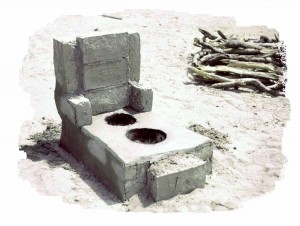Mud-brick stove under construction
From: Tubob: Two Years in West Africa with the Peace Corps
The Sahara Desert encroaches closer to The Gambia each year. The need for firewood for cooking, plus drought conditions have created a scarcity of trees. Women and children often walk great distances to gather enough wood for fires.
My husband Bruce longed for projects where he could feel more productive. In reading about alternative energy at the Peace Corps library, he learned about building a stove which would use less fuel than an open fire.
Along the meandering path we used to go into Basse, we passed a place where men made mud bricks. The soil had to be the right mixture of clay and sand to make usable bricks. We watched as they dug up the clay mixture and patted it into molds, then left them to dry in the sun. The mud bricks were used to build huts and smaller structures for grain and peanut storage. The bricks would eventually melt or crack, but their lives could be extended if covered with a thin layer of concrete.
Bruce bought a supply of the mud-bricks and they were delivered by a donkey-pulled cart. He had talked to Binta and her husband Mosalif about his project and discussed where in the compound a good place would be to build the stove. The firebox was about three feet long, eighteen inches wide. Bruce borrowed Binta’s two cooking pots so that he could make openings in the top to exactly fit her pots.
It was our hope that this idea would catch on and others would make this simple stove. The firebox, closed on three sides and sealed on top with the cooking pots, required far less fuel than an open fire. A small chimney directed smoke away from the cook’s eyes.
Days went by, but Binta didn’t use her new stove. Finally, Bruce asked Mosalif why.
“I must build a building around it,” Mosalif replied. Traditionally, the Fula don’t cook in the open. We were aware that there were covered cooking areas, but we had also seen many Mandinka and Wolof cooking in the open, though not the Fula. Binta’s current cooking area was the space between walls of her hut. In our hut, that space was where we took our bucket baths.
Many times I had called on Binta and sat in that space while she cooked. It was unbelievably hot and the smoke made my eyes burn. The next weekend Mosalif gathered the materials, grass for thatched roofing, and krinting, such as used for fencing, for the walls. A couple of his friends helped him build the cook hut around the new stove.
Finally, the day came when Binta cooked her first meal on the stove. They were impressed with how much less fuel it took and by how much faster she could fix a meal. Although a few village people did come to look at it, unfortunately the idea didn’t catch on.



Pingback: Mary E. Trimble: Building a Mud-Brick Stove | CamanoCommunity
Interesting Mary. Hard to believe the “stove” didn’t catch on. Some long held beliefs and ways of doing things are hard to change. Good of Bruce to try to help and maybe in some way he did make a change, even if a small one.
Yes, change is difficult. We found that the best we could do was show people other ways of doing things…and hope for the best.